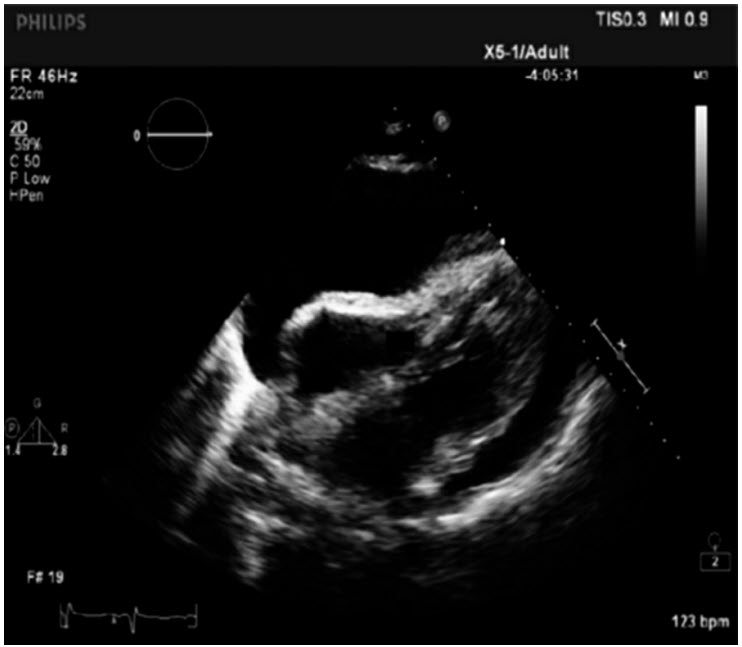Question 3#
A 46-year-old male with a remote history of resected stage IIA non– small-cell lung cancer presents to the emergency room with dyspnea and chest pain. He is tachycardic, tachypneic, and hypotensive. CXR shows mediastinal lymphadenopathy and bilateral pleural effusions. Bedside transthoracic echocardiogram (TTE) was performed and an image is shown below.

What is the next most appropriate step in management?
A. HeparinB. Cardiac surgical consult
C. Aspirin, clopidogrel, and heparin
D. Fluid resuscitation
Correct Answer is B
Comment:
Correct Answer: B
The subcostal view image from the TTE demonstrates a large pericardial effusion and right ventricular compression. Given the history and findings on CXR, this is highly likely to be a malignant pericardial effusion. Malignant pericardial effusion has a high probability of recurrence often requiring pericardial window for definitive management. Drainage of the effusion and subsequent referral for definitive management is also a reasonable approach, but that option is not given here. Malignant pericardial effusion can be seen in numerous tumor types, with lung being the most common. In lung cancer, it is thought to occur via spread from local lymphatics rather than direct pericardial invasion. It is associated with a very poor prognosis, although long-term survival is occasionally seen in the current era of targeted therapeutics. Prognosis is most strongly related to treatability of the underlying malignancy rather than any details of the tamponade. Heparin would be appropriate therapy for pulmonary embolus, which can present with shortness of breath and chest pain, but that diagnosis would not explain the echo findings. Aspirin, clopidogrel, and heparin could be a reasonable step in management of an acute coronary syndrome, but that diagnosis is again not consistent with the echo. Fluid resuscitation is mainstay of therapy for hypotension, but, in this case, there is a readily reversible cause of low blood pressure and intervention should be carried out without delay.
References:
- Wilkes JD, Fidias P, Vaickus L, Perez RP. Malignancy-realted pericardial effusion: 127 cases from the Roswell Park Cancer Institute. Cancer. 1995;76:1377-1387.
- Li BT, Pearson A, Pavlakis N, et al. Malignant cardiac tamponade from non-small cell lung cancer: case series from the era of molecular targeted therapy. J Clin Med. 2015;4:75-84.
- McCurdy MT, Shanholtz CB. Oncologic emergencies. Crit Care Med. 2012;40:2212-2222.